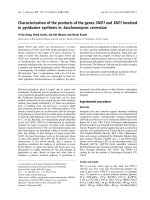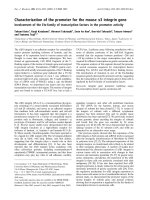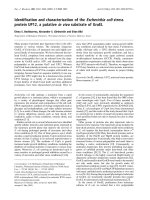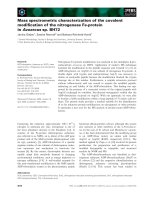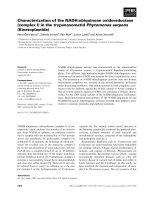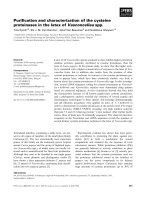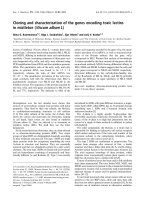characterization of the cenozoic petroleum system in the northeastern offshore song hong basin
Bạn đang xem bản rút gọn của tài liệu. Xem và tải ngay bản đầy đủ của tài liệu tại đây (859.57 KB, 28 trang )
MINISTRY OF EDUCATION AND TRAINING
HA NOI UNIVERSITY OF MINING AND GEOLOGY
____________________
TRAN CHAU GIANG
CHARACTERIZATION OF THE CENOZOIC
PETROLEUM SYSTEM IN THE NORTHEASTERN OFFSHORE
SONG HONG BASIN
Subject area: Engineering geology
Code: 62.52.05.01
SUMMARY OF DOCTORAL THESIS WORK
HANOI -2014
The thesis work has been completed at: Ha Noi University of Mining
and Geology
Principal Advisors:
1) Professor, Doctor of Science. Mai Thanh Tan
2) Dr. Le Tuan Viet
Judge 1: Associate Professor, Doctor. Pham Huy Tien
Judge 2: Dr. Nguyen Huy Quy
Judge 3: Dr. Cu Minh Hoang
The doctoral thesis work will be defend at the University Council of
Scoring Thesis Meeting at the Hanoi University of Mining and
Geology at …….hour, day ……., month……year ……
You can find out the thesis in the libraries: National Library, Hanoi
or Library of Ha noi University of Mining and Geology
1
INTRODUCTION
The necessity
Song Hong Basin is complex sedimentary basin, including several
tectonic elements with different oil and gas potential. The VPI-
IDENMITSU (2005-2007) project has confirmed non-marine dual
petroleum system (lacustrine and fluvio-deltaic) in the Song Hong
basin by advanced geochemical analysis. Due to no oil – source rock
correlation, the characterization of petroleum system in the
Northeastern offshore Song Hong basin has yet to be confirmed.
In 2008, the oil discovery by 106-HR-1X has proven the
hydrocarbon potential of the Pre- Cenozoic carbonate basement Play.
Next well 106-HR-2X was drilled through the oil reservoir bearing in
the Pre – Cenozoic carbonate basement and penetrated a thick shale.
It is a questionable that this Pre- Cenozoic shale is a new source
rock. Well 107-PL-1X drilled in 2013 in the rich organic source area,
and has the same structural trend as 106-HR prospects. However the
well was dry. Other latest exploration wells have discovered gas
condensate with heavy H
2
S and CO
2
polluted in the reservoir fluid.
These facts show many issues have to resolved such as the quality
and distribution of source rocks, or which risk factor of geological
parameters in the petroleum system have affected the results of
exploration in the area of Northeastern (NE) offshore Song Hong
basin. Therefore, the topic "Characterization of the Cenozoic
petroleum system in the Northeastern offshore Song Hong Basin"
was chosen with the objectives and research tasks are as follows:
Objectives:
2
- To get better understand about the characterization and area
distribution of petroleum source rocks of Cenozoic sediments in the
NE offshore Song Hong Basin.
- Contribute to improve the methodology for petroleum systems
evaluation and risk analysis in exploration.
Tasks:
- Integrate geological data and geophysical data to clarify the
regional geological setting.
- Research to clarify the characterization and level of maturity
and timing of HC generation and migration, identify the origin oil
generated source rock in the NE offshore Song Hong Basin.
- Determine the area distribution of source rocks and HC potential
areas.
Object and scope of the study:
The scope of the study include the block 106 area, Northwestern
of block 102 and North part of block 107 offshore Song Hong basin
that separated to others area by Song Lo fault. The objective to study
is Cenozoic petroleum system.
Thesis protection:
Thesis 1. Study results of the geochemical characterization
identified a lacustrine petroleum system related to the Oligocene
source rock exist in the NE offshore Song Hong Basin. The source
rock contains moderate to good organic richness, kerogen type II and
mixed type II/ III, locates in the grabens and half grabens within the
study area. Based on all available geochemical data of the Miocene
shale and Pre- Cenozoic shale that identifies these shales are not
qualified to be a source rock.
3
Thesis 2. Based on the study of factors impact on risk of the
petroleum system such the origin, maturity, the Oligocene sediment
thickness and the distribution of potential prospects, restore the
geological development through the ages that are enable to identify
the Thuy Nguyen graben has lowest exploration risk. Next is the
Kien An graben. The South Bach Long Vi Island area and NW edge
of block 102 are the areas of high exploration risk.
New findings of the thesis work:
- Based on latest exploration data, results of thesis work has
contributed accurately geochemical characteistics of the NE offshore
Song Hong basin. The Pre- Cenozoic shale below the carbonate layer
bearing oil has terrestrial lithoface, deposites under oxidizing
condition environment, with poor organic contain that is not
qualified to be a source rock.
- The new structural maps were built have contribution to get
better understand of Late Oligocene inversion event affect oil and
gas potential of the area of Northeatern Offshore Song Hong basin.
The scientific and practical contributions:
* Scientific contribution: The results of research allowed identify
the characterizations and the distribution of source rock to get better
understand of petroleum system in NE of Song Hong basin, offshore
Vietnam.
* Practical contribution: Contribute to improve the effectiveness
of HC potential assessment for the NE of Song Hong basin, and to
serve the Oil companies in the exploration and exploitation activities.
The layout of the thesis:
The thesis consists of 04 chapters excluding the introduction and
conclusions, recommendations, papers publication and reference
4
lists. The entire content of the thesis is presented in 135 pages, 24
tables and 89 figures.
Chapter 1
SUMMARY GEOLOGICAL STRUCTURE IN THE
NORTHEAST AREA OFFSHORE SONG HONG BASIN
1.1. Overview the geology of study area
1.1.1. Location
Study location is part of
Northeast Song Lo fault offshore
Song Hong basin. Water depth
from 30-40m. (fig.1.1)
1.1.2. Exploration history
Fisrt exploration work began
in 1978. In 1988, first PSC was
signed for block 106, and a part
of block 102, 103 and 107
between PVN and TOTAL. In
1992, IDEMITSU – PVN signed
a PSC for block 102/91. Next the
blocks 102 – 106 with total area
of 10700 km
2
was signed
between PVN and ATI
Petroleum Inc in 2000. Recently,
this PSC has relinquished area
and maintained in area of 225
km
2
. The remaining area now is
Fig. 1.1: Structural map of Top
basement Song Hong basin and
study area location (N.T.Dau. et
al, 2012)
block 102/10 and block 106/10 with PVEP operator. From 1990 to
present, in the study area were acquired more than 15,000 km of 2D,
5
and over 3000 km
2
of 3D seismic, more than 10 exploration wells.
Several studies are available as Geochemical model of Song Hong
Basin (N.T Dau, L.V Hien, 1997), Outcroup study in Bach Long Vi
island, Do Son, Kien An, Elephant Mountain, and Cat Ba Island (P.Q
Trung, 1998), Investigate the amount of HC generated and migrated
from source rock to trap in the Song Hong basin by SIGMA 2D and
BSS softwares (N.T.B Ha, 2010), Final Report on the analysis and
modeling Song Hong Basin (VPI - GEUS, 2001), Report on
Characterization of petroleum systems in the Song Hong Basin by
State of the art Geochemical Technology (VPI-IDENMITSU, 2007).
1.2. Regional setting
1.2.1 Lithostratigraphy
Song Hong Basin
stratigraphic units consist of: (i)
Pre-Cenozoic basement; (ii) Phu
Tien Formation (E
2
pt); (iii) Dinh
Cao Formation (E
2
đc); (iv)
Phong Chau Formation (N
1
1
pc);
(v) Phu Cu Formation (N
1
2
pc);
(vi)Tien Hung Formation
(N
1
3
th); (vii) Vinh Bao
Formation; (viii) Formation of
Hai Duong - Kien Xuong (N
2
-Q)
(Figure 1.2).
1.2.2 Tectono-structure
There exist in the study area
02 fault systems. The NW-SE
and NE-SW fault systems.
Fig.1. 2: Stratigraphic column of
the offshore Northeast S.Hong
basin (After N.T.Dau et.al, 2012)
6
These fault systems created structural type of dipping down to the
basin center and formed a series of grabens alternate half grabens.
The identified structural zonnation (Figure 1.3):
Hai Phong Shelf:
The shelf located in the
northeastern part of the
study area, covers a
large area of the block
106 and block 101.
Thanh Nghe
undifferentiated
monocline: It is located
Fig.1. 3: Fault systems and structural
zonnation
to the West of the Song Chay fault.
Central trough: can be subdivided as
a) Miocene Inversion Zone
b) Dong Quan trough
North-East differentiated monocline: mades up of grabens, half
grabens, horsts, and basement uplifts. Detaily consists of:
a) Kien An Graben
b) Tien Lang - Chí Linh horst
c) Thuy Nguyen half graben
d) Trang Kenh Nose
e) Western Bach Long Vi trough
f) Yen Tu Horst
g) Southern Bach Long Vi trough
Tectonic evolution was constructed based on restoration cross
sections. The study results show the similarities and differences over
the period of development of the region on the two banks of Song Lo
7
Fault. In Paleocene-Eocene to the Early Oligocene and Pliocene –
Quaternary period are similar but different in period from late
Oligocene to late Miocene.
1.3. Data base
The documents use in thesis work are more than 15000 km 2D
seismic, gravity maps of the Bac Bo Gulf, Vietnam geological maps,
well logs and obtained rock samples were analyzed for the
Petrography, Geochemistry, and Biostratigraphy studies. Especially
with 500 m of core samples from Enreca – 3 well in Bach Long Vi
island to study sedimentary, litho-facies, and geochemistry of
Oligocene sediment.
Chapter 2
RESEARCH METHODS
2.1. Petroleum system and its role in oil and gas exploration
Petroleum system concept appears too many different definitions.
The term “system” includes source rock and reservoir rock, oil -
source correlation are considered a key factor in determining system
(Dow W.G, 1972). Synthesis of the concept put forward by many
authors, petroleum system is understood as a natural system where
exist generated petroleum source rocks with all the geological
elements and geological processes related to the ability to
accumulate oil and gas may occur.
In 1988, L.B Magoon had established a system classification,
which distinguishes the petroleum systems to sedimentary basins,
Plays and Prospects. Depend on the level of research, petroleum
system is evaluated as an overview to detail as scale of a country,
sedimentary basin, a play and to each independent prospect. The
basic methods of assessment can be summarized as follows:
8
+ Analysis petroleum system was evaluated on the basis of the
total volume of HC generated/rock volume by Exxon.
+ Analysis petroleum system was evaluated on the prediction of
petroleum geology characteristic (Delphi method), mainly based on
the experience of experts.
+ Analysis petroleum system was evaluated on Geochemical
material balance based on the calculation of the amount of oil and
gas generated from source rock, as well as oil and gas were migrated
and can accumulate in the trap.
+ Analysis petroleum system was evaluated on extrapolation of
production history.
+ Analysis petroleum system
by Play fairway analysis (based on
geological model and statistical
data) allows determine the change
of the geological factors related to
the oil and gas accumulation in an
considered region.
Figure 2.1: Play concept
[CCOP, 2000]
In the thesis work, Play assessment is applied to solve remaining
problems in petroleum system in the study area.
2.2. The geochemical methodology
Complex sets of geochemical index in evaluating the capacity of
HC generation of sediments used in the thesis are:
+ Combust a crushed sample of rock at 600ºC
+ Pyrolysis method Rock-Eval standards (RE)
+ Bitumen extraction method
+ Chromatography (GC)
+ Mass spectrometry analysis (GC-MS)
9
+ The vitrinite reflectance (Ro,%)
2.3. Geochemical modeling
Geochemical modeling can
reproduce the processes relating to
petroleum system in computer
from past to present time, which
enables to assess the timing and
location of generation, migration
and accumulation of Oil and Gas.
The soft ware used is SIGMA-2D.
Principles for SIGMA model is
explained detail as figure 2.2.
2.4. Petroleum system analysis
According to Magoon and Dow
(1994) to study a petroleum system
have to analyze four basic
elements includeing: source rock,
Fig 2.2: SIGMA 2D outline
reservoir, seal and the overlying rock layer with the combination of
three processes are: the formation of oil and gas traps, the oil and gas
generation, migration and conservation of oil and gas after trapped.
2.5. Geological risk assessment
The purpose of risk assessment in petroleum system analysis is to
estimate the probability of discovery prior to drill of a prospect/play.
The probability of discovery is defined as the product of the
following major probability factors, each of which must be evaluated
with respect to presence and effectiveness. According to CCOP risk
assessment guideline, the 04 factors are: Reservoir (P1), Trap (P2),
Petroleum charge system (P3), and retention after accumulation (P4).
10
The probabilities of these factors are estimated with respect to the
presence and effectiveness of the geological process associated with
them. The probability of discovery is calculated using the formula:
P = P
1
*P
2
*P
3
*P
4
(2.1)
Where
P: Probability of discovery oil and gas (or probability of
simultaneous occurrence of the events associated with each
independent)
P1: The probability of the presence of reservoir rock includes: i)
P1a: Probability of existence of reservoir facies; ii) P1b: Probability
of effectiveness of the reservoir
P2: The probability of the presence of a trap includes: i) P2a the
probability of presence of the mapped structure and ii) P2b the
probability of effective seal mechanism for the mapped structure
P3: The probability factor for the petroleum charge system
includes: i) P3a the probability of effective source rock and ii) P3b
the probability of effective migration
P4: Probability of effective retention of HC in the prospect after
accumulation.
Tab.2.1: Probability of
existence of reservoir facies
Tab 2.2: Probability of
effective reservoir with depth
11
In essence, the probability of discovered of an object is:
P = P1a* P1b* P2a* P2b* P3a* P3b*P4 (2.2)
Probability value of each parameter is defined rely on subjective
knowledge, extrapolation from the analysis geological and statistical
data. Following the guidance of CCOP, for example, the tables 2.1
and 2.2 describe the probabilities of P1a and P1b parameters.
Chapter 3
CHARACTERIZATION OF SOURCE ROCK IN THE
OFFSHORE NORTHEAST SONG HONG BASIN
3.1. Organic richness in source rock
+ Pre-Cenozoic sediments: very poor in organic matter and not
be generated oil and gas. TOC values from 0.03 to 0.05% weight.
Unmeasurable indicators S1, S2, PI, HI and Ro.
+ Eocene sediments: no wells confirm met Eocene.
+ Oligocene sediments: organic matter is moderate to good. 8/14
samples in 106-HR-1X well have TOC values> 1%. Samples on
Bach Long Vi Island with TOC values from 1.5 to 6.59%, 10/100
samples have S1 value from 0.08 to 1.19 mg/g, and 99/100 samples
with S2 > 10 mg/g, in average of 17 mg/g represented the organic
contain from good to very good.
+ Lower Miocene sediments: all samples get very low value, so
not analyisis.
3.2. Kerogen type
+ Oligocene sediments: Figures 3.1a and 3.1b (N.T.B.Ha, 2010)
show the Oligocene (brown points) found in wells in block 107 and
Chi Linh –Yen Tu host with HI values <300mgHC/gTOC for
samples with low maturity distributed in kerogen type III. The
sample has a higher maturity distributed in kerogen type II. Source
12
rock is able to generate mixture oil and gas and have reach maturity
level.
Figure 3.1a: Plot HI and Tmax by
the structural zonnation in the
Song Hong Basin (NTB Ha,
2010)
Figure 3.1b: Plot (S1 + S2 mg/g)
and TOC% by structural
zonnation in Song Hong Basin
(NTB Ha, 2010)
Results of the well ENRECA 3 on Bach Long Vi Island show
sample populations fall into the group of kerogen type II and I.
Oligocene sediments have oil prone with capability from fair to good
(Figure 3.2 a, b) .
+ Lower Miocene sediments: almost HI <200 mgHC/ gTOC,
kerogen type III, expressed in gas prone. Four samples obtained at
106-YT-1X shown capable of oil generation.
+ Middle Miocene sediments: HI value changes from 50 to <300
mgHC/gTOC, kerogen type III, with gas prone. Samples at 106 YT-
1X with HI values up to 456-520 mg/g, kerogen type II/III with both
oil and gas generation potential. The Mid. Miocene samples in 107-
PL-1X well are also have potential of both oil and gas generation.
13
Figure 3.2a: Plot HI and Tmax at
well ENRECA 3
Figure 3.2b: (S1+S2 mg/g) và
TOC % at well ENRECA 3
3.3. Depositional environement of organic matter
The HI vs TOC diagram (Figure 3.3), results of gas
chromatography (GC) (Figure 3.4) indicate depositional environment
of organic matter of Oligocene source rocks in the study area is
mainly lacustrine origin.
Results of gas chromatography (GC) from Oligocene, Lower
Miocene at 106-HR-1X, 106-HR-2X, 107-BAL-1X reflect the origin
of organic matter was derived from high plants (Figure 3.5a, b).The
Ts/Tm vs Oleanane/C30 Hopane diagram was used (Okui et al,
2007) to distinguish lacustrine petroleum system from fluvio-deltaic
petroleum system. This plot indicates the oil from Ham Rong field is
lacustrine origin.
3.4. Maturity of source rock
+ Oligocene sediments: Vitrinite index (Ro,%) from well Enreca
-3 has value <0.4% and Tmax values from 410-440
o
C. Two shale
samples in well 106-HR-2X (3209-3917m) with Tmax values
measured 444-445
o
C are at oil window. Data reveal the Oligocene
14
sediments have varied thermal maturity level from low maturity to
oil window.
+ All Lower and Middle Miocene samples from Ham Rong-Yen
Tu and Pha Lai wells are immature.
Figure 3.3: The diagram defines
Oligocene depositional
environment of organic matter in
Song Hong Basin (points brown)
(NTB Ha, 2010)
Figure 3.4: The diagram
defines depositional
environment of organic matter
by Pr / C17 and Phy / C18 in
the study area (Ha, 2013)
Figure 3.5a: The
Oleanane/C30Hopane vs
Ts/Tm diagram of study area
Figure 3.5b: Steranes C27-
28-29 triangle chart
15
3.5. Oil to source rock correlation
Oil sample from Ham Rong was analysed that shows normal
crude oil and displays API gravity of 39,22
0
API, moderate wax
content (11,3%), moderate viscosity (4,058Cst) and moderately low
pour point (27
0
C). This oil is low sulphur content (0,062%Wt), low
nickel and vanadium contents (Ni=1,70ppm, V=trace) suggesting
characteristics of C class (After Barwise, A.J.C, 1984) derived from
lacustrine source rocks.
Results of gas chromatogram of the DST#1 oil from 106-HR-2X
show the presence of saddle shape distribution decreases with
increasing number of carbon atoms (Figure 3.6 and 3.7).
Figure 3.6: C15+ saturates
chromatogram of oil and
extracts from 106-HR-1X
Figure 3.7: C15+ saturates
chromatogram of oil and
extracts from 106-HR-2X
Pristane/phytane ratio is 2,95 and 2,9 for 106-HR-1X ST4, and
106-HR-2X respectively. Consequently, these features are typical of
organic matter derived from a terrestrially dominated source,
deposited in submerged environment under reducing and weak
oxidizing conditions.
The GCMS analysis of saturate fraction of crude oil from Ham
Rong field (Figs. 3.8a & 3.9a), the mass fragmentograms of m/z191
16
shows a wide Hopane distribution, gradually decreased with
reducing number of carbon atoms, which are recognised as organic
matter derived from a terrestrially dominated source, deposited in
reducing environment condition. The presence of Oleanane is land
plant indicators. Distribution of Tricyclic Terpanes sharply
appearence from T2 to T8 suggested lacustrine algae have
contributed in the parent material.
(a)
(b)
Figure 3.8: Gas chromatography-
Mass Spectrometry (GCMS) of
saturates fraction of oil sample from
106-HR-1X
(a)
(b)
Figure 3.9 Gas
chromatography-Mass
Spectrometry (GCMS) of
saturates fraction of oil
sample from 106-HR-2X
The m/z 217 sterane distribution (Figures 3.8b and 3.9b) is
characterised by C29 steranes are higher than those of C27 and C28.
These features suggest the oil derived from terrestrial source. The 4-
Methyl C30-Sterane (peak 42) widely confirmed as the oil is derived
mainly from lacustrine algal organic matter.
17
Oil – Source rock correlation defines the origin of oil generated
from lacustrine algal organic matter that match with Oligocene
source rocks in the study area.
3.6. H
2
S origin in crude oil
Worldwide rift lakes in the Paleocene and Eocene have met in
Spain, southern France, in Utah and Colorado (USA). They formed
in surface of Carbon-Permian or Devon limestone. By this the
carbonate material easily osmoses in the lake that created favorable
condition for carbonate development of along the evaporation zone
of lakes.
The exploration wells in the study area have penetrated thin
limestone in the Oligocene. Theoryly, the H
2
S and CO
2
pollution in
the oil reservoir in the Ham Rong fields were the product of thermal
sulfate reduction process (of CaSO
4
) in carbonate rocks explained
by Angler-Gofer Scheme formula:
CaSO
4
+ CH
4
= CaS + CO
2
+ 2H
2
O (3.1)
CaS + CO
2
+ H
2
O = CaCO
3
+ H
2
S (3.2)
Chapter 4
DISTRIBUTION OF SOURCE ROCK AND POTENTIAL
ZONNATION IN THE OFFSHORE NORTHEART SONG
HONG BASIN
4.1. Oligocene sediment distribution and evolution
On the basis of seismic data and results of latest wells, Phd
student have participated to re-interprete some seismic lines at VPI
workstation. Results of biostratigraphic studies are used to identify
and interprete the seismic reflection surface include:
+ Top Kainozoic basement
+ Top Lower intra- Oligocene (U500)
18
+ Top of uncomformity is near top of Lower Oligocen (U400)
+ Top Oligocene (U300)
+ Top intra Middle Miocene (U220)
+ Top Upper Miocene (U100)
Some of these seismic horizons just matched tie within a small
area. Oligocene stratigraphic sequence in the center area of block
106 can divide into two parts separated by U400, which is relatively
continuous. 107-TPA-1X supposedly was drilled to
Eocene?/Oligocen (U500). Well ties to seismic data just observed in
the small troughs in the NE Song Lo fault and the Southern part of
Bach Long Vi Island. The structural maps of Top Basement, Top
U400, Top U300 and the isopach map of Oligocen in scale 1/200.000
were built.
The isopach maps of Lower Oligocene (U400-Bsmt) and
Oligocene (U300-Bsmt) (Figures 4.1 and 4.2) represent the
distribution area of Oligocene significant altenated in the offshore
Northeast Song Hong basin. Figure 4.1 shows at the end of Early
Oligocene time, 02 closed lakes systems trending NE-SW and NW-
SE were developed in the study area. The basement hosts within
Ham Rong field area as boundary separate the lakes. In the Northern
part of block 107, which is belong to South Bach Long Vi trough
also has a deep lake. The lakes in Southeast edge of block 106 and
North of block 107 tend to be open to the Southeast, while the closed
lakes within the Northwest of blocks 102-106 and Northeast Yen Tu
host remain stable development.
Three (03) geological and physical seismic sections were selected
cut through the main structural zonations in the study area to
19
investigate the level of development of the Oligocene sediment in
between Top of basement to Top Oligocen (U300).
Figure 4.1: Isopach map of
Lower Oligocene (U400-
Bstm)
Figure 4.2: Isopach map of
Oligocene (U300-Bstm)
The chronostratigraphy chart of seismic line 89-1-100 represents
at early stage of basin formation, a series of grabens and half grabens
filled by Oligocene sediment in the Eastern area of block 106. At
about 28 Ma in this area had experienced a compression phase
resulting in local cockle, inversion that lead to erode a big volume of
sediment during approximately 5 million years. On this line shows
the area of lakes reduced during period from Early Oligocene to Late
Oligocene.
On line 89-1-36a shows initially there some grabens development
in the area of Northwest block 102-106. These lakes are smaller than
that lakes developed in the Eastern part of block 106. During stage of
deposition, whole area was not be affected by Late Oligocene
compression phase. Sediment were supplied and filled up the
grabens.
On line 89-1-54 shows a large volume of sediment filled up the
grabens in the Southwest block 102 that resulted in strong subsidence
20
and inheritedly development of series deep grabens from Oligocene
to Late Miocene time. Meanwhile in the central part of block 106
extending to Hai Phong shelf, the grabens just developed to end of
late Oligocene time, then area was sinking and less affected by
tectonic fault activity.
4.2. The factors for evaluating the potential of petroleum system
4.2.1 Process of source rock maturity and HC generation
The time of HC generation of Oligocene source rock is significant
difference according to the location survey points. Oligocene source
rock that observed in the Southeast block 106 has ealy HC
generation about 20 Ma . Recently, this source rock is still
generating oil and gas. At the lower part of Oligocene section, it is at
dry gas phase. In the Nortwestern block 106, at the lower Oligocene
section, source rock has started HC generation in about 14 Ma, while
the upper Oligocene is about 11 Ma.
4.2.2 Characterizations of carbonate reservoir basement
Nine (09) exploration wells in the study area were drilled into the
Cenozoic basement and penetrated carbonate reservoir rock. The
documents of side wall cores, FMI log and wireline logs measured in
Ham Rong host show multi-types porosity ie: inter-granular,
vugs/cave and fractures. The vugs/cave porosity was calculated
separately from other. The rest types of porosity were calculated
together based on response of the density and neutron logs and
considered as “matrix+fractured” porosity. The porosity values from
side wall core samples are all less than 1%. The average porosity of
basement rock is 7% determined by logs. Cavern porosity if 100%.
As mentioned above, two main types of porosities were identified:
the “matrix+fractured” and cavern porosities. The NTG of these
21
porosities were also identified separately. For fractured basement
segment the NTG ratio varies from 0,45 to 0,7. Meanwhile the NTG
of caver is applied 0,002 to 0,03 with assumption of cavern height
analog from Ha Long Bay. Results reservoir testing measured
average permeability of 10 mD before aciding in basement rock and
40mD after aciding treatment, with horizontal permeability was
measured respectively at 8474 mD.ft and 21000 mD.ft
4.2.3 Seal characterization
Oligocene and Miocene shales play as local seal for carbonate
buried hill traps in the study area. Their thickness is from 20-150 m
with high clay contain (Illit > 50%, Kaolinit <30%). Pliocene shale is
regional seal with thickness from 300 to over 500 m widely covere
all the area. However, the Pliocene sediment is unconsolidated
therefore low seal quality.
4.2.3 Characterization of carbonate buried hill traps
The oil and gas discovery from carbonate buried hill traps in the
study area are in paleo-grabens, where thick Oligocene sediment
cover directly on top and two wings of prospect structure. The thick
shale layer has proved as local seal and important source rock. Area
of basement structures less than 10 10 km
2
with their relief from 200-
400m.
4.2.5 Timing of HC generation, migration and trap formation
The petroleum
system of the
Northeast offshore
Song Hong basin is
summary in table
4.1.
Table 4.1: Petroleum system chart of the
Northeast offshore Song Hong basin
22
.
4.3. Risk assessment and potential zonnation
The results of seismic interpretation and mapping represent the
carbonate buried hill potential traps still remain in the study area.
They locate in the shallow water of northwest edge of block 102
(Tien Lang), in the Kien An and Chi Linh host, Thuy Nguyen half
graben, and South Bach Long Vi trough. All these structures are
close to the drilled wells. Review detaily results of drilled wells are
able to identify risk factors that will improve process risk analysis in
the study area. The analysis is performed on the assessment of the
involved geological processes and the facts of geological time.
Geological processes are firstly started with the formation of the
reservoir rock, next is the formation of a closed trap in relation to the
maturity of source rock, HC migration from source rocks to reservoir
rocks, the accumulation of HC in the trap and eventually progresses
after trapping and accumulating of hydrocarbons contained in it. The
main goal is just to know where is the location has above mentioned
factors are favorable or unfavorable to oil in carbonate basement play
and determine the value of probalilities.
Based on the guidance of
CCOP, 04 geological
factors are: reservoir
(P1), trap (P2), petroleum
charge system (P3) and
retention of HC (P4) are
used to estimate the
chance of success in term
Fig.4.3: Potential zonnation of carbonate
23
of geology, and predicte
the entirely change or
basement Play in the NE Song Hong
basin
partly change of geological factors in the a petroleum system of
Northeast offshore Song Hong basin. Figure 4.3 presents the
potential zonnations of the study area.
CONCLUSIONS AND RECOMMENDATIONS
The study results allows to point out some conclusions:
- Lacutrine Oligocene shale has been identified as an important
source rock exsit in the study area. This source contains moderate to
good organic richess, kerogen type II and mixed type II/ III with
early to oil windown of matutiry level. Recently, source rock in
Southeast block 106 is in wet gas phase. The source rock at Bach
Long Vi island has kerogen type II/I, good to excellent organic
richess, oil prone. Oligocene source in the study area has experienced
two phases of HC generation. Early phase is from 20 to 14 Ma; the
second phase is from 11 to 7 Ma. Time of HC generation varies by
structural zonnations within the study area. In deep grabens, this
source rock is still generating in HC.
- Crude oil from 106-HR basement reservoir is lacustrine algaes
origin. Results of biomarker analysis from oil are agreed with
extracts obtained from Oligocene source rock.
- Based on all available geochemical data, the Miocene shale and
Pre- Cenozoic shale are not identify as a source rock.
- Study results of geological development of Oligocene sediment
and history of local tectonic inversion express a large volume of
sediment were erodied during Oligocene to end of Late Miocene
time within the Bach Long Vi area. This is risk for timing factor of



